
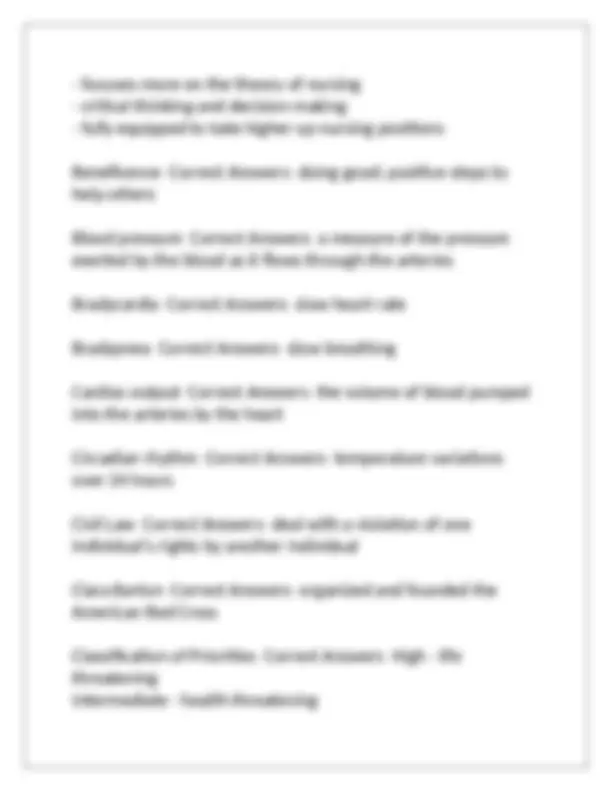
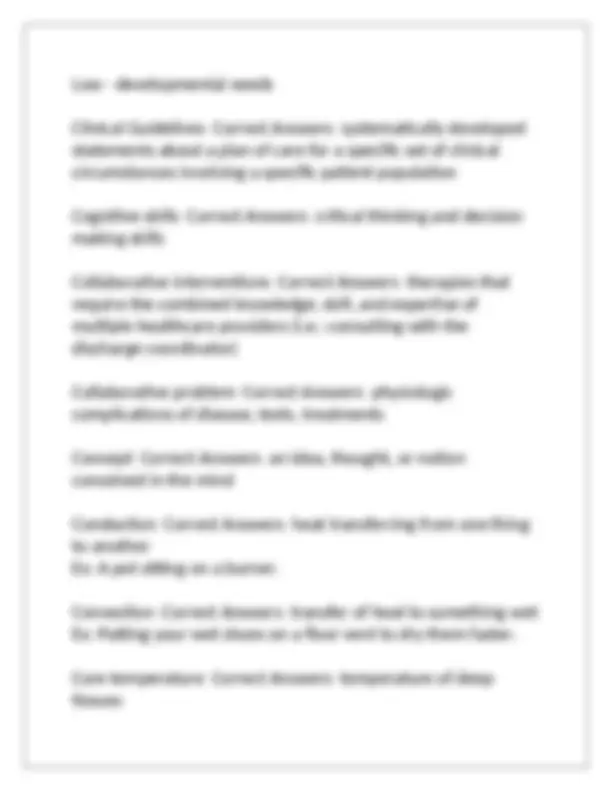
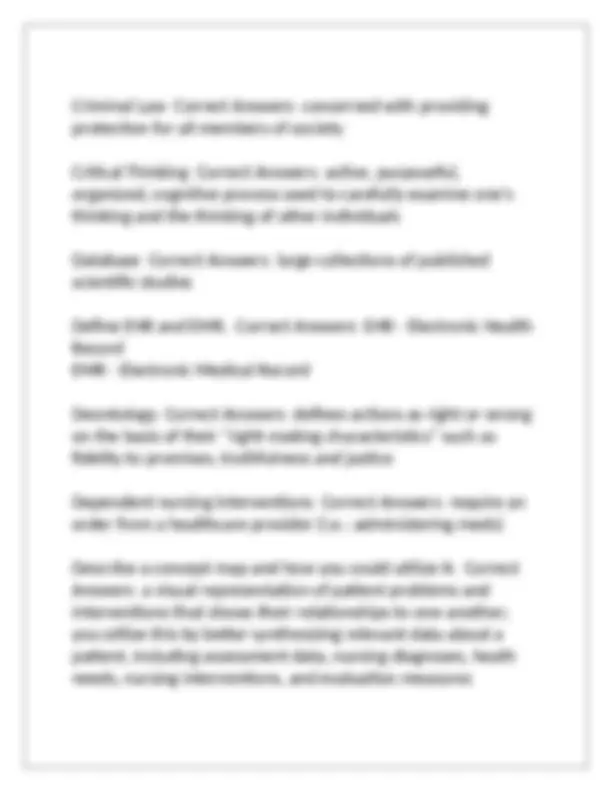
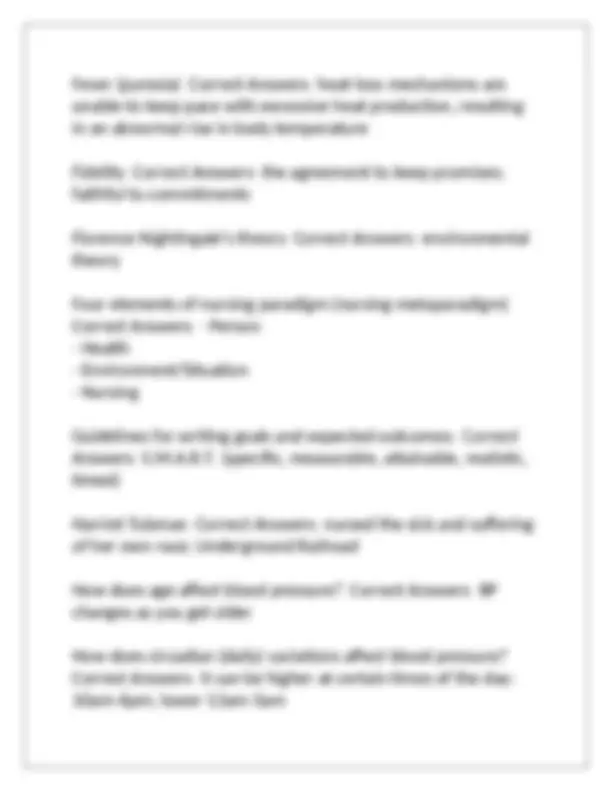
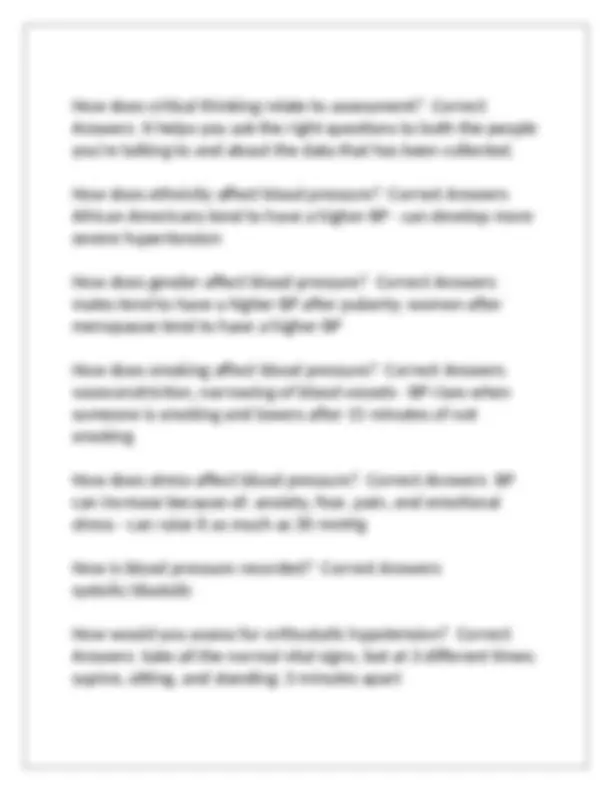
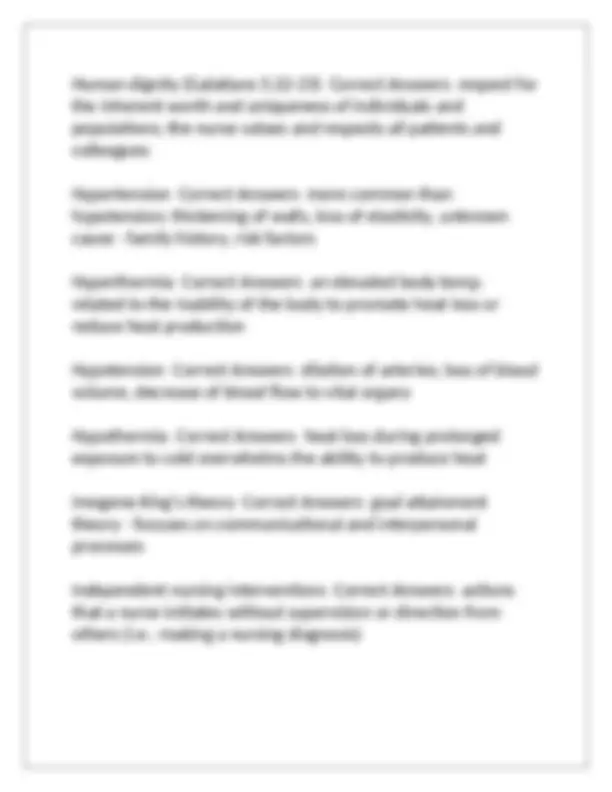
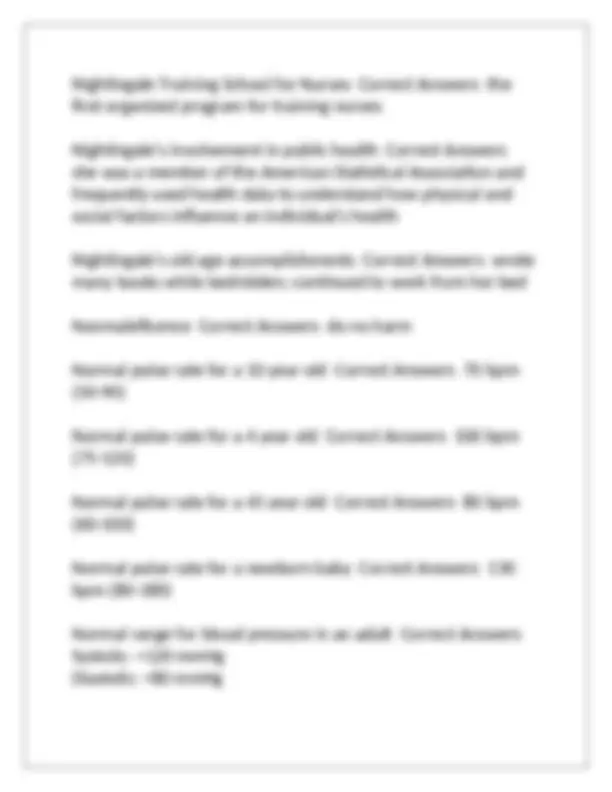
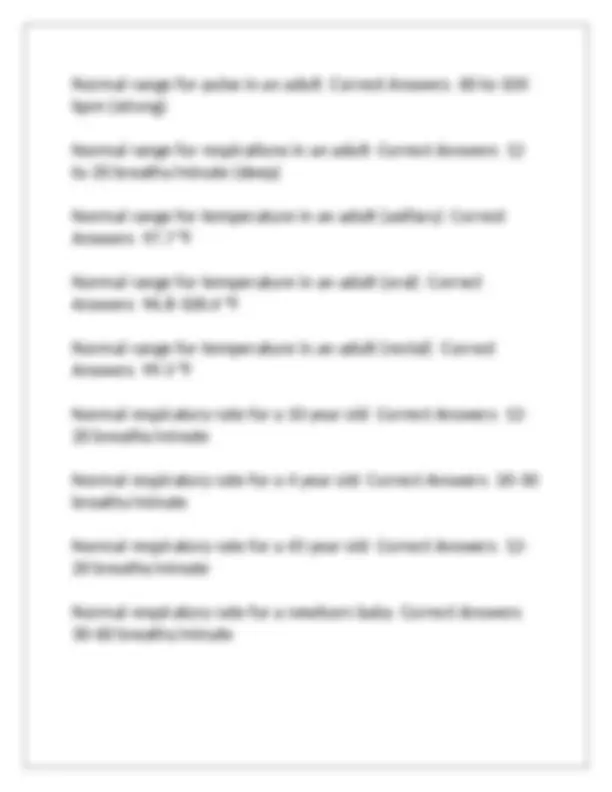
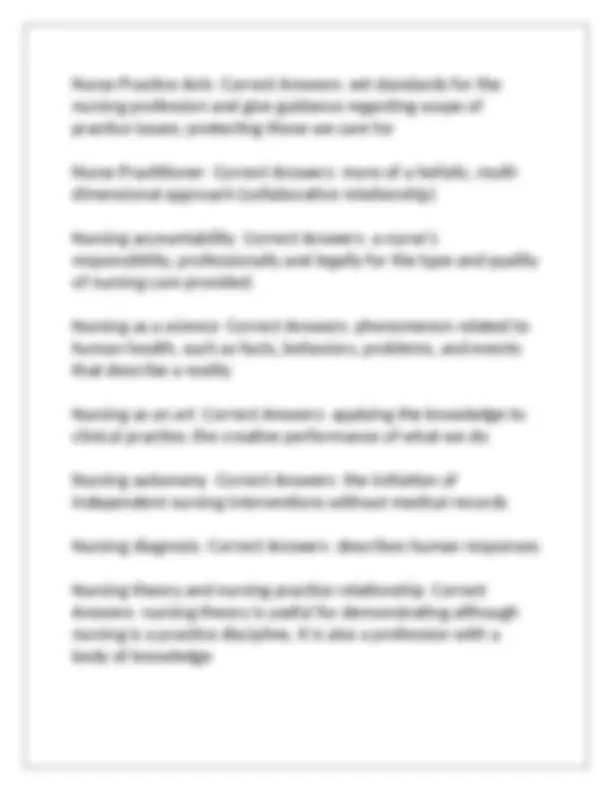
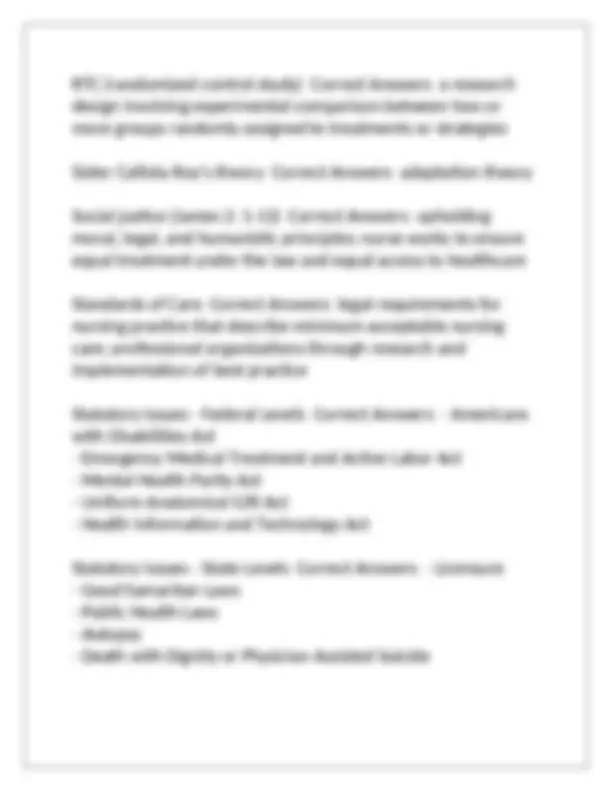
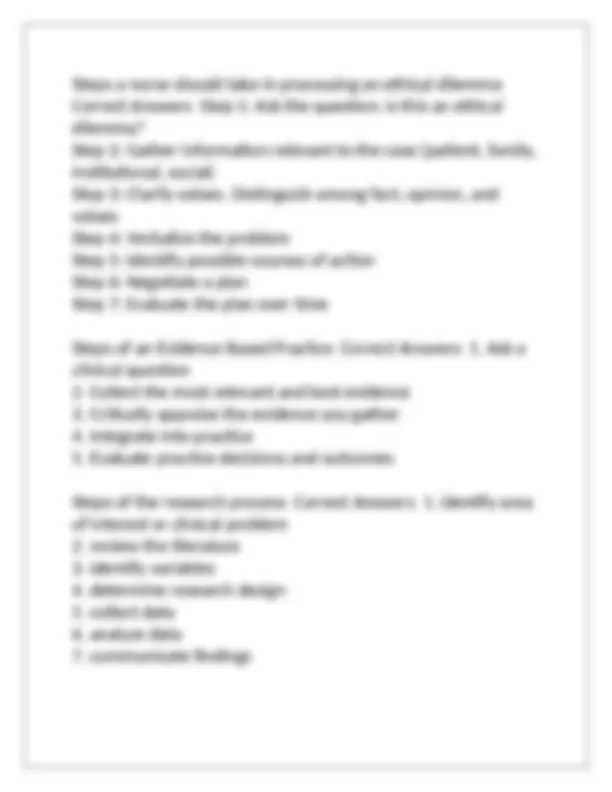
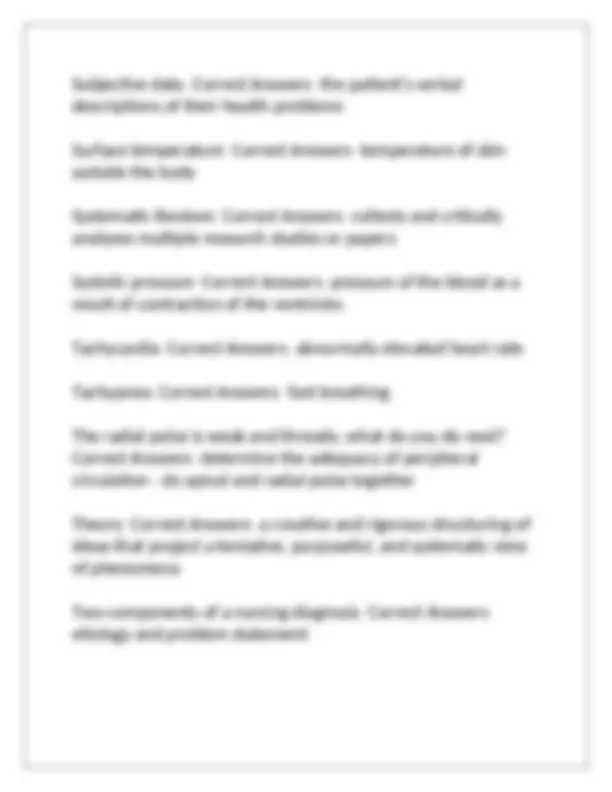
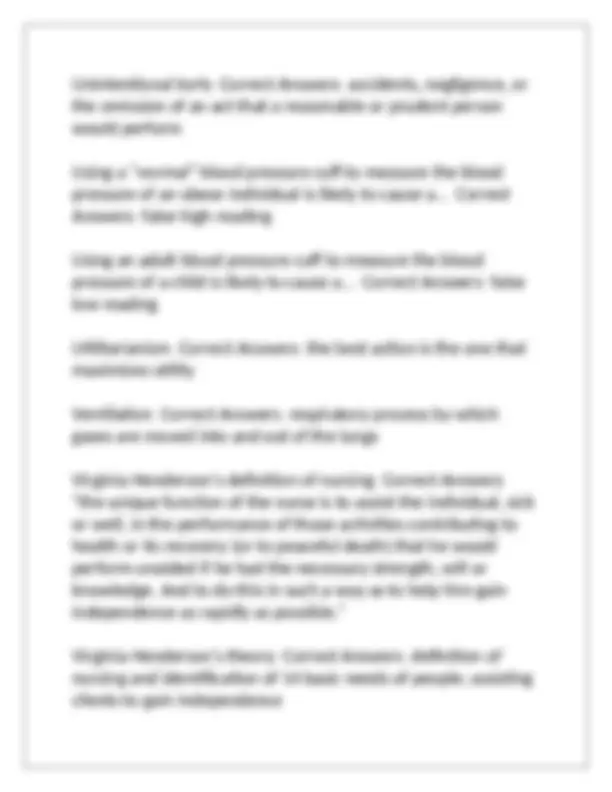
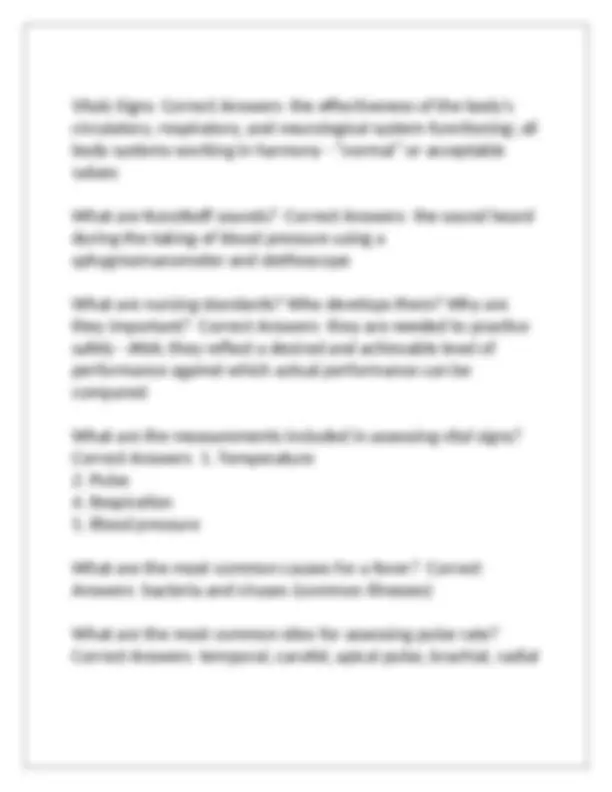
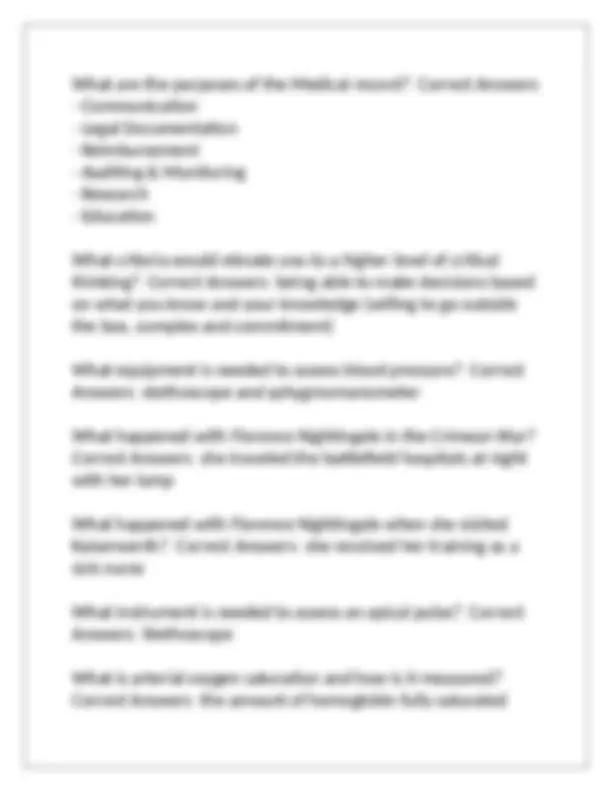

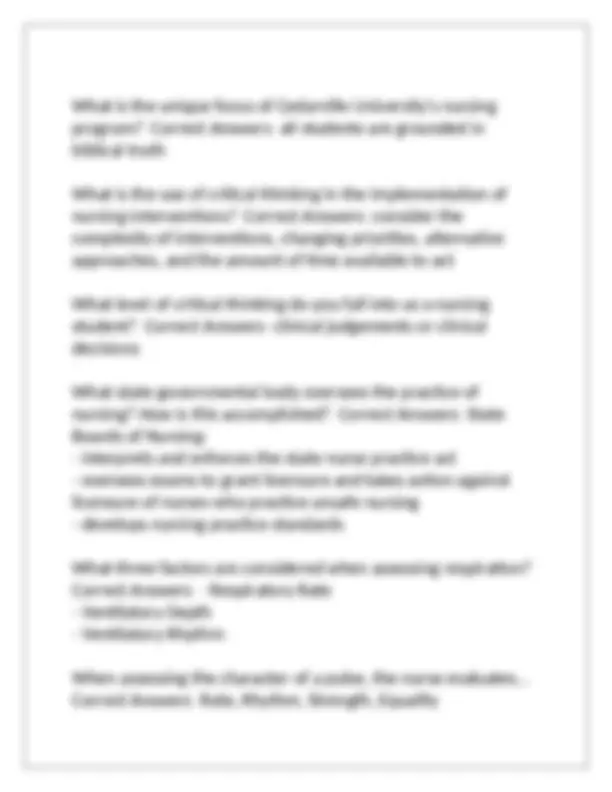
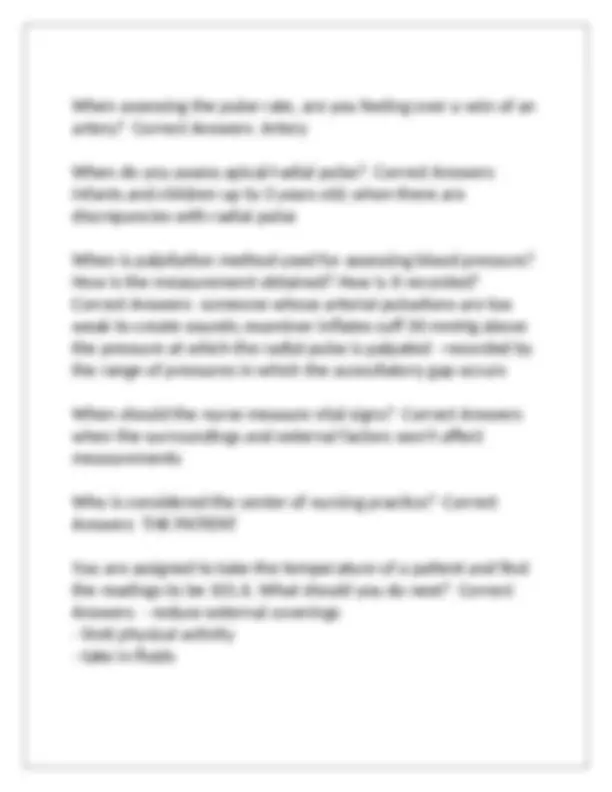


Study with the several resources on Docsity

Earn points by helping other students or get them with a premium plan


Prepare for your exams
Study with the several resources on Docsity

Earn points to download
Earn points by helping other students or get them with a premium plan
Community
Ask the community for help and clear up your study doubts
Discover the best universities in your country according to Docsity users
Free resources
Download our free guides on studying techniques, anxiety management strategies, and thesis advice from Docsity tutors
A comprehensive set of questions and answers for the nursing 1000 final exam at cedarville university. It covers a wide range of topics, including nursing theories, ethical principles, assessment techniques, and clinical interventions. A valuable resource for students preparing for their final exam, offering insights into key concepts and providing a framework for understanding the material.
Typology: Exams
1 / 26

This page cannot be seen from the preview
Don't miss anything!



















Nursing 1000 Final - Cedarville University Questions With Complete Solutions According to the National Institute of Nursing Research, what are the key areas of focus for health care research? Correct Answers 1. build the scientific foundation for clinical practice
ANA definition of nursing Correct Answers illustrates the consistent commitment of nurses to provide care that promotes the well-being of their patients and communities ANA definition of professional nursing Correct Answers "the protection, promotion, and optimization of health and abilities, prevention of illness and injury, facilitation of healing, alleviation of suffering through the diagnosis and treatment of human response, and advocacy in the care of individuals, families, groups, communities, and populations." Apnea Correct Answers absent breathing Associate degree program (ADN) Correct Answers - 2 years of school
Low - developmental needs Clinical Guidelines Correct Answers systematically developed statements about a plan of care for a specific set of clinical circumstances involving a specific patient population Cognitive skills Correct Answers critical thinking and decision making skills Collaborative interventions Correct Answers therapies that require the combined knowledge, skill, and expertise of multiple healthcare providers (i.e.: consulting with the discharge coordinator) Collaborative problem Correct Answers physiologic complications of disease, tests, treatments Concept Correct Answers an idea, thought, or notion conceived in the mind Conduction Correct Answers heat transferring from one thing to another Ex: A pot sitting on a burner. Convection Correct Answers transfer of heat to something wet Ex: Putting your wet shoes on a floor vent to dry them faster. Core temperature Correct Answers temperature of deep tissues
Criminal Law Correct Answers concerned with providing protection for all members of society Critical Thinking Correct Answers active, purposeful, organized, cognitive process used to carefully examine one's thinking and the thinking of other individuals Database Correct Answers large collections of published scientific studies Define EHR and EMR. Correct Answers EHR - Electronic Health Record EMR - Electronic Medical Record Deontology Correct Answers defines actions as right or wrong on the basis of their "right-making characteristics" such as fidelity to promises, truthfulness and justice Dependent nursing interventions Correct Answers require an order from a healthcare provider (i.e.: administering meds) Describe a concept map and how you could utilize it: Correct Answers a visual representation of patient problems and interventions that shows their relationships to one another; you utilize this by better synthesizing relevant data about a patient, including assessment data, nursing diagnoses, heath needs, nursing interventions, and evaluation measures
Domain Correct Answers the perspective or territory of a profession or discipline Dorothea Dix Correct Answers recruited and supervised nurses for the Union Army Dorothea Orem's theory Correct Answers self care theory Dyspnea Correct Answers sensation of shortness of breath Dysrhythmia Correct Answers an internal interruption by an early or late beat indicates an abnormal rhythm Eupnea Correct Answers normal breathing Evaporation Correct Answers water evaporating into a gas Ex: Water leaving the skin. Evidence Based Practice Correct Answers a process finding, appraising, and applying scientific evidence to the treatment and management of health care; the discovery of underlying trends and principles developed from the accumulation and refinement of a large body of studies Febrile Correct Answers the hypothalamus set point drops, initiating heat-loss responses
Fever (pyrexia) Correct Answers heat-loss mechanisms are unable to keep pace with excessive heat production, resulting in an abnormal rise in body temperature Fidelity Correct Answers the agreement to keep promises; faithful to commitments Florence Nightingale's theory Correct Answers environmental theory Four elements of nursing paradigm (nursing metaparadigm) Correct Answers - Person
Human dignity (Galatians 5:22-23) Correct Answers respect for the inherent worth and uniqueness of individuals and populations; the nurse values and respects all patients and colleagues Hypertension Correct Answers more common than hypotension; thickening of walls, loss of elasticity, unknown cause - family history, risk factors Hyperthermia Correct Answers an elevated body temp. related to the inability of the body to promote heat loss or reduce heat production Hypotension Correct Answers dilation of arteries; loss of blood volume, decrease of blood flow to vital organs Hypothermia Correct Answers heat loss during prolonged exposure to cold overwhelms the ability to produce heat Imogene King's theory Correct Answers goal attainment theory - focuses on communicational and interpersonal processes Independent nursing interventions Correct Answers actions that a nurse initiates without supervision or direction from others (i.e.: making a nursing diagnosis)
Integrity (Ephesians 4:15) Correct Answers acting in accordance with an appropriate code of ethics and accepted standards of practice; honest in all aspects of nursing Intentional torts Correct Answers the professional intends to do harm and does harm Interpersonal skills Correct Answers communication with patients Isabel Hampton Robb Correct Answers founded Nurses Association Alumnae of US and Canada Jean Watson's theory Correct Answers theory of human caring
Nightingale Training School for Nurses Correct Answers the first organized program for training nurses Nightingale's involvement in public health Correct Answers she was a member of the American Statistical Association and frequently used health data to understand how physical and social factors influence an individual's health Nightingale's old age accomplishments Correct Answers wrote many books while bedridden; continued to work from her bed Nonmaleficence Correct Answers do no harm Normal pulse rate for a 10 year old Correct Answers 70 bpm (50-90) Normal pulse rate for a 4 year old Correct Answers 100 bpm (75-120) Normal pulse rate for a 45 year old Correct Answers 80 bpm (60-100) Normal pulse rate for a newborn baby Correct Answers 130 bpm (80-180) Normal range for blood pressure in an adult Correct Answers Systolic: <120 mmHg Diastolic: <80 mmHg
Normal range for pulse in an adult Correct Answers 60 to 100 bpm (strong) Normal range for respirations in an adult Correct Answers 12 to 20 breaths/minute (deep) Normal range for temperature in an adult (axillary) Correct Answers 97.7 °F Normal range for temperature in an adult (oral) Correct Answers 96.8-100.4 °F Normal range for temperature in an adult (rectal) Correct Answers 99.5 °F Normal respiratory rate for a 10 year old Correct Answers 12- 20 breaths/minute Normal respiratory rate for a 4 year old Correct Answers 20- breaths/minute Normal respiratory rate for a 45 year old Correct Answers 12- 20 breaths/minute Normal respiratory rate for a newborn baby Correct Answers 30-60 breaths/minute
Objective data Correct Answers the observations or measurements of a patient's health status Orthopnea Correct Answers abnormal condition in which a person must sit or stand in order to breathe comfortably Orthostatic hypotension Correct Answers when a normostatic person develops symptoms and a drop of systolic or diastolic pressure by at least 20 mmHg within 3 minutes of rising to an upright position Paradigm Correct Answers a pattern of beliefs used to describe the domain of a discipline Peer-Reviewed Articles Correct Answers published scientific studies written by others in the medical field Perfusion Correct Answers pumps oxygenated blood to the tissues and return deoxygenated blood to the lungs Physician's Assistant Correct Answers mirrors that of physicians (provides comprehensive care) Professional Nursing Code of Ethics - its purpose Correct Answers a set of guiding principles that all members of a profession accept; carrying out nursing responsibilities in a manner consistent with quality in nursing care and the ethical obligations of the profession
Psychomotor skills Correct Answers integration of cognitive and motor activities (i.e.: injections) Pulse Correct Answers the number of heartbeats per minute Pulse deficit Correct Answers an inefficient contraction of the heart that fails to transmit a pulse wave to the peripheral pulse site Qualitative research Correct Answers the study of research questions about human experiences. (data = words or observations) Quantitative research Correct Answers the process of testing relationships, differences, and cause-effect interactions among and between variables and test intervention effectiveness. (data = numbers) Quasi-intentional torts Correct Answers intent may not be there, but "direct cause" occurs Radiation Correct Answers heat coming off of the body Ex: A person placing their cold hands over a fire. Roles of a Nurse: Correct Answers care giver, client advocator, manager, communicator, educator, counselor, case manager, research consumer, leader
Steps a nurse should take in processing an ethical dilemma Correct Answers Step 1: Ask the question: is this an ethical dilemma? Step 2: Gather information relevant to the case (patient, family, institutional, social) Step 3: Clarify values. Distinguish among fact, opinion, and values Step 4: Verbalize the problem Step 5: Identify possible courses of action Step 6: Negotiate a plan Step 7: Evaluate the plan over time Steps of an Evidence Based Practice Correct Answers 1. Ask a clinical question
Subjective data Correct Answers the patient's verbal descriptions of their health problems Surface temperature Correct Answers temperature of skin outside the body Systematic Reviews Correct Answers collects and critically analyzes multiple research studies or papers Systolic pressure Correct Answers pressure of the blood as a result of contraction of the ventricles Tachycardia Correct Answers abnormally elevated heart rate Tachypnea Correct Answers fast breathing The radial pulse is weak and thready, what do you do next? Correct Answers determine the adequacy of peripheral circulation - do apical and radial pulse together Theory Correct Answers a creative and rigorous structuring of ideas that project a tentative, purposeful, and systematic view of phenomena Two components of a nursing diagnosis Correct Answers etiology and problem statement